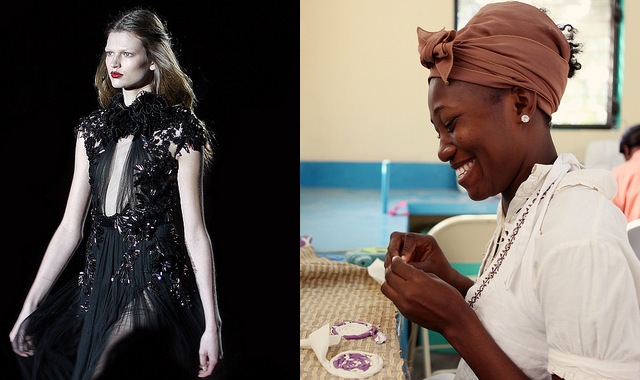By Helen Cross
Perched upon a hilltop in Solemo in a medieval village in beautiful Umbria lies the workroom of Italy’s “King of Cashmere”. Brunello Cucinelli’s business quarters are a thousand miles from the frenetic streets of fashion’s traditional capitals, philosophically if not physically. Umbria is a place that has shied away from modernisation, a place where the “pray and work” mentality of Catholic, family-orientated people still runs deep.
This ambrosial setting complements perfectly Cucinelli’s humanist enterprise, a business that is run on the philosophy of “supreme good”, something he defines as “giving business a meaning that goes beyond profit and reinvesting to improve the lives of workers, to enhance and restore the beauty of the world.” And Cucinelli certainly practices what he preaches, gaining favourable coverage in June for paying each of his 700 employees an impromptu bonus of €6,300. Interestingly, the designer believes that his business model is mandated by the consumer, despite the fact that the fashion industry has traditionally been seen as ambivalent towards corporate social responsibility (CSR):
“Luxury consumers want to know, or will want to know, that their goods are made humanely.”
However, as mass market brands such as H&M and Primark have seen the storm of negative PR following revelations of sweat shops and child labour, the luxury industry has, thus far, remained unscathed.
So, is Cucinelli right? Are we moving into an era of ethical high end fashion? An era of sustainable artisanship rather than luxury? Or, as some experts suggest, is high end fashion philosophically at odds with sustainability? After all, this is an industry that is defined by frivolity, by pumping out four collections a year and convincing consumers that perfectly good clothes are outdated after a season. The question, according to some, is one of cognitive dissonance. A study in the Journal of Consumer Research found that consumers are resistant to social responsibility when brands exhibit inconsistencies. Therefore, brands who aren’t typically associated with CSR and its connotations may find a negatively impacted image as the result of CSR programs. The study’s co-author, Carlos Torelli, summarized his findings:
“When people see an ad with two opposing motivations, as when a brand known for self-enhancement promotes a CSR message, something doesn’t feel right. Consumers sense a disfluency or a motivational conflict between the brand’s self-aggrandizing ethos and its selfless CSR message that results in distrust and less favorable appraisals.”
This would seem to suggest that companies with CSR “baked in” to their image, such as Cucinelli, will likely see a result, and brand enhancement, from CSR whereas more individualistic brands will not.
Interestingly, many mass luxury labels such as Gucci, Louis Vuitton and Prada started in a similar manner to Cucinelli: as skilled artisans, crafting exceptional goods. However, as luxury became mass market, these brands moved away from their humble beginning to become global conglomerates, fiercely protective of their luxury status whilst feeling the economic need to appeal to all sectors of society. Despite their luxury image, many designer brands outsource production to cheaper countries, much as their less prestigious counterparts do, and many “gateway” designer products, such as perfumes and accessories, are made with cheap ingredients and potentially hazardous chemicals.
So where do the big names in fashion currently stand on CSR? A 2012 study titled Style Over Substance by the Ethical Consumer Research Association (ECRA) found damning results. A number of high profile fashion houses, including Prada, Alexander McQueen, LVHM and Armani, were assessed according to animal rights, human rights, the environment, political activities and anti-social finance practices. A questionnaire was sent out to each company, but none responded, and publicly available information was scant. Additionally, brands such as Stella McCartney and Vivienne Westwood, were criticized: McCartney for being vocally anti fur whilst being owned by the fur using Gucci group, Westwood for being openly anti-climate change whilst having no policies to back up the stance.
There are some encouraging signs, however. In March 2013 Gucci introduced a high profile global CSR program, taking a stance on women’s rights; likewise Tiffany launched a specialist sustainability website in 2011 which sets out the sourcing policies for their diamonds. What’s more, there is a new wave of fashion brands who have sustainability and artisanship as a key business focus such as Maiyet and Bruno Pieter.
Perhaps this new focus on sustainability is a sign of fashion coming full circle: from artisanal beginnings, to global megabrands and back again. In troubling economic times, brass commercialism can seem tactless, whilst quality can be seen as a return to traditional values. As consumers feel the pinch, luxury becomes more about quality than whimsy, and labels such as “Made in Italy” become more important than brand names and logos. The meteoric rise of websites such as Etsy can be seen as evidence of this: a need to buy from real people rather than purchasing across a corporate veil. Likewise, social media means consumers are now far more confident in challenging the status quo, taking luxury brands out of their Ivory Towers and into a genuine two way conversation.
 ABOUT THE WRITER
ABOUT THE WRITER
Helen Cross has been working in online marketing for a number of years; however her position at The British Assessment Bureau has allowed her to develop her interest in corporate social responsibility and sustainability. When not working she can be found seeking out deserted beaches, off the beaten track destinations and the perfect coffee.
Photo by Mathieu Lebreton/ Feed My Starving Children (FMSC)




